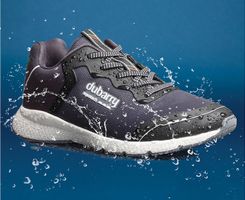Deck Shoes vs. Regular Shoes: The Essential Guide to Comfortable Marine Footwear
September 2024
Proper footwear is essential for entering the world of yachting or marine adventure. When it comes to choosing comfortable marine footwear for yacht crews, there is always confusion about deck shoes and regular shoes.
While both shoes serve the same purpose of protecting your feet, deck shoes for sailing are preferred as they are more compatible with the marine environment. By the end of this blog, you will learn why deck shoes should be preferred over regular shoes.

What Are Deck Shoes?
Deck shoes are footwear that are specifically suited for the maritime environment and activities related to it. The first deck shoe was invented in the 1930s by Paul Sperry, who allegedly fell overboard while sailing around Long Island. After seeing his dog run across the ice without slipping, Sperry was inspired by the features of the dog’s paws that ensured traction on the slippery surface. He cut thin slits of rubber to create shoe soles that could provide grip even in the wet conditions.
Over time, the term “deck shoes” has become synonymous with this specific type of footwear. It is now widely used to describe shoes that share the same characteristics and functionality, whether used on a boat or not.
Deck Shoes vs Regular Shoes
1. Purpose and Design
Deck Shoes: These shoes are specifically designed for boats and yachts. They’re crafted to provide stability, grip and water resistance, making them a perfect choice for slippery decks and wet conditions.
Regular Shoes: These shoes are made for everyday use and activities like running and hiking. They do not have the grip or any other specialized features necessary for marine decks.
2. Slip Resistance
Deck Shoes: These shoes feature non-slippery rubber soles with specific tread patterns to offer maximum traction on wet surfaces, reducing the chances of slipping on boat decks.
Regular Shoes: Most regular shoes do not have slip-resistant soles, especially when exposed to water or slick surfaces. Their grip is usually designed for dry, stable conditions.
3. Water Resistance
Deck Shoes: Deck shoes dry very quickly while maintaining comfort. They’re made with water-proof materials like treated leather or canvas. Due to the waterproof materials, deck shoes can handle wet conditions.
Regular Shoes: Generally, regular shoes are not water-resistant and may become heavy, uncomfortable, and take a long time to dry once soaked.
4. Sole Construction
Deck Shoes: The key feature of deck shoes is their non-marking soles. These soles are particularly important for maintaining the appearance of the boat’s surface as they do not leave any scuffs or marks on the deck.
Regular Shoes: Regular shoes often have dark-coloured soles that can leave marks or scuffs, which is not ideal for a boat’s deck.
5. Comfort for Long Wear
Deck Shoes: Designed with comfort in mind for long hours spent on your feet, deck shoes often include cushioned insoles and breathable materials. They are lightweight and flexible to accommodate the movement and agility needed on a boat.
Regular Shoes: While some regular shoes are comfortable for extended periods, they are typically not designed for the unique movement or conditions found in marine environments.
6. Durability in Harsh Marine Conditions
Deck Shoes: Built to withstand harsh marine conditions like saltwater, sun, and constant exposure to moisture. They maintain their shape and functionality even after prolonged exposure to these elements.
Regular Shoes: Regular shoes may deteriorate quickly in such conditions. Exposure to saltwater and moisture can cause them to lose their shape, become uncomfortable, and require frequent replacements.
Conclusion: The Right Shoe for the Right Environment
So, next time you’re headed out to sea, ensure your footwear is as prepared as you are.
When it comes to marine activities, choosing the right footwear is more than just a fashion statement; it’s about safety, comfort, and durability. Deck shoes are the clear winner for anyone spending time on the water, offering features that regular shoes simply can’t compete with. From superior grip to water resistance and long-lasting comfort, they are ideal for yacht crews and sailing enthusiasts alike. Regular shoes, while suitable for dry land, just don’t hold up to the demands of life on deck.
